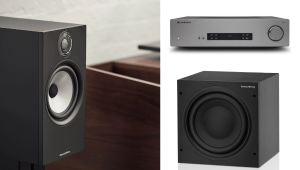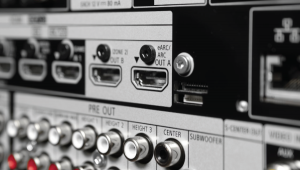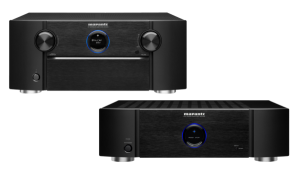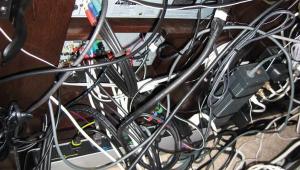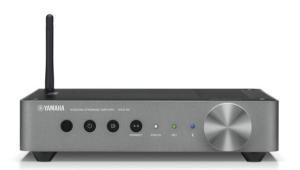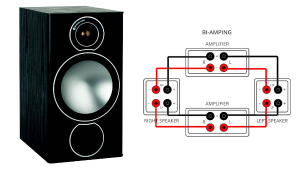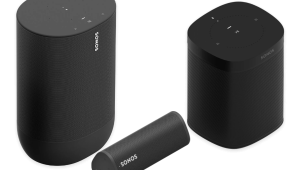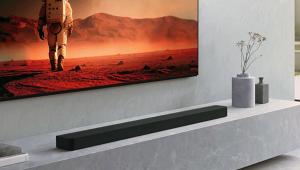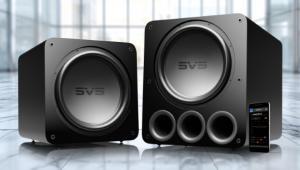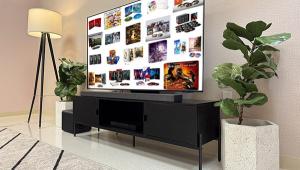Sub Size, Upscaling, Blu-ray

What is the recommended size for a subwoofer in a room measuring 19x17 feet? How big does the sub need to be for home theater?
Harry Rutgers
The size of the subwoofer is far less important than where you place it and where you sit, though in very general terms, the larger the room, the larger the sub needs to be to fill that room. Your room is of moderate size, so any sub of moderate size will be fine.
I recommend thinking more about where to put the sub. According to one approximation determined by master acoustician Floyd Toole, the sub should normally be placed at the half or quarter point along one wall. (In the diagram above, the depicted side-wall positions are a bit off-center.)
Also, your seats should not be at even fractions of the room's dimensions (half, quarter, etc.) in order to avoid the inevitable dips and peaks at certain low frequencies that occur at those locations. Neither should your seats be placed right up against a wall because the bass will inevitably be too loud and boomy there.
The procedure to find the best location for the sub in a particular room is rather involved. One technique is called the "subwoofer crawl," which goes like this: First, place the sub at your listening position and play some familiar music. Then, crawl around the perimeter of the room to find the spot at which the bass sounds the most smooth and even. That's the place to put the sub, which will then produce the most even bass at your listening position.
Are You Kidding?
Is video upscaling just a gimmick? One of our source devices is a Toshiba HD DVD player that is supposed to upscale standard-definition DVDs to 1080, but 90 percent of the time, we get a message to the effect of, "Upscaling is prohibited for this content, playback will be limited to 480." I think that upscaling is a gimmick that cheats by making educated guesses about the pixels it is "filling in," but I feel kind of cheated by this supposed feature.
Scott Ward
I strongly disagree that video upscaling is just a gimmick. It's important to upscale a standard-def image to the resolution of the display; otherwise, the image would occupy only a small portion of the screen. Yes, it's "guessing" what should be in the pixels it creates to fill in between the actual data, but this can be done fairly well these days. Of course, some products do it better than others, but this is always the case.
Regarding the HD DVD player, are you using its component-video output? If so, that's your problemHD DVD players won't upconvert DVDs to 1080i or 1080p for output via component; they will only output 480p via component. They will upconvert to 1080p via HDMI, so use that connection if possible. If you must use component, the signal will be upscaled by an HD display anyway.
Blu-ray Quandary
I have a Hitachi 57F59A RPTV that can accept 1080i but not 1080p. It has the older HDMI 1.0 and component inputs. Would I notice a big upgrade in picture quality with Blu-ray even though my TV isn't 1080p and only has the older version of HDMI? Is 1080i at least better than 720p? Also, would the older HDMI even past the new Dolby TrueHD and DTS-HD signals, or would I have to go 6-channel analog out to my Denon AVR2308 receiver?
I noticed at Target that the new Star Trek movie was $14.99 on DVD, but the cheapest Blu-ray edition was $29.99, and all the Blu-rays were twice as much as their DVD counterparts. Is Blu-ray really twice the picture quality of DVD, even on my TV, or would I need to upgrade my TV to see any big difference?
Even though I'm not a gamer, I was thinking of getting the Sony PS3 for watching Blu-ray movies since the price was recently dropped. But is the new smaller, cheaper PS3 still as good as the original, and does it have all the features of the original, or did they cut features when they cut the cost and made it smaller?
Tim Neal
First of all, your TV is CRT-based, which probably means it displays a high-def image with 1080 horizontal lines in an interlaced fashion—that is, it "draws" the odd-numbered lines followed by the even-numbered lines. Thus, it theoretically has the same resolution with a 1080i or 1080p signal, but it cannot accept a 1080p signal, so if you get a Blu-ray player, you will have to set it to output 1080i. You might or might not see deinterlacing artifacts depending on the TV's internal video processor.
In my opinion, you will see a marked improvement in picture quality from Blu-ray compared with DVD. Will to be twice as good? Perhaps not, but it will be clearly better. Also, I think 1080i is generally better than 720p from a Blu-ray player, especially when feeding a display with 1080-line resolution, because sending 1080i avoids two scaling stagesone in the player going from 1080p on the disc to 720p before outputting the signal, and the other in the TV going back to 1080p.
No version of HDMI before 1.3 can accommodate Dolby TrueHD or DTS-HD. A 6-channel analog connection can, but none of the Sony PS3 models have such an output. (Otherwise, they are excellent Blu-ray players.) Other dedicated Blu-ray players do have these outputs, and many can be found in the $200 range.
As for the PS3, Home Theater reviewer David Vaughn says the new model is even better than the originalmuch quieter in terms of physical noise and no compromise in terms of picture and sound quality. Sony eliminated the emulator chip, so the new model can't play PS2 games as the original could, but since you're not a gamer, that's not an issue. Also, it has two fewer USB ports and no on/off switch on the rear, but again, these are no big deal in my book.
BTW, I've seen Star Trek on Blu-ray for $19.99 at Amazon and Walmart.
If you have a home-theater question, please send it to scott.wilkinson@sorc.com.


